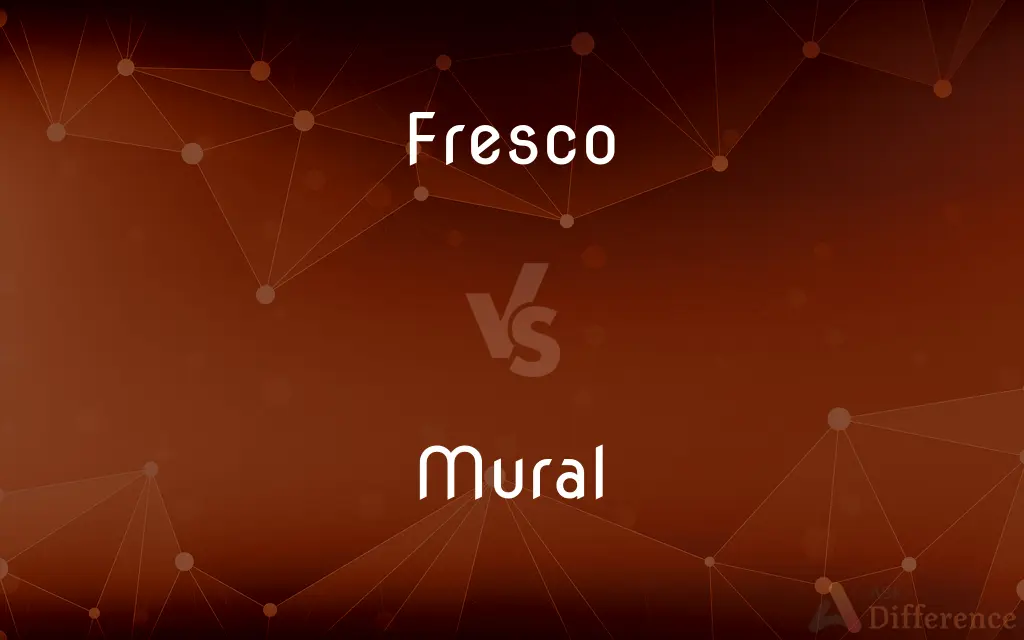Fresco vs. Mural — What's the Difference?
Edited by Tayyaba Rehman — By Urooj Arif — Updated on April 20, 2024
Fresco involves painting on wet plaster with pigments mixed in water, resulting in a durable artwork as the wall absorbs the color; murals can be painted on any surface using various techniques, offering more versatility.

Difference Between Fresco and Mural
Table of Contents
ADVERTISEMENT
Key Differences
Fresco is a technique where the artwork is integrated into the plaster of a wall or ceiling. The pigments, mixed with water, are applied on freshly laid wet plaster, allowing the painting to become part of the wall as it dries. Whereas murals are large-scale paintings done on walls but can use different techniques such as oil, acrylic, or spray paint, and are not limited to wet plaster.
Frescoes require the artist to work swiftly before the plaster dries, necessitating careful planning and speed in execution. On the other hand, mural artists can take their time, adjusting and adding details as they go, thanks to the variety of mediums and techniques at their disposal.
The durability of frescoes is notable; the colors become part of the wall, which makes them remarkably long-lasting and resistant to peeling or fading. In contrast, murals may require protective coatings to ensure longevity and may be more susceptible to environmental factors depending on the materials used.
Historically, fresco was a dominant form of wall painting in ancient and Renaissance times, particularly famous in Southern Europe. Murals, however, have been a form of artistic expression worldwide, prominently used in modern public art and often associated with cultural or political messages.
The environmental conditions for creating a fresco are quite specific, needing a balanced humidity and temperature to ensure proper drying and adhesion. Murals are more adaptable, able to be created in a wider range of environments and on various surfaces including brick, wood, and concrete.
ADVERTISEMENT
Comparison Chart
Base Surface
Wet plaster
Any surface (e.g., drywall, concrete)
Technique
Water-based pigments on wet plaster
Various (e.g., acrylic, oil, spray paint)
Durability
High (pigments absorbed into wall)
Variable, often requires protective coatings
Execution Time
Must be completed quickly (plaster drying time)
More flexible timing
Cultural Significance
Associated with ancient and Renaissance art
Broadly used globally across all historical periods
Compare with Definitions
Fresco
Requires specific environmental conditions to be successful.
The humidity and temperature must be carefully controlled when creating a fresco.
Mural
Often used to convey public messages or beautify spaces.
Many urban areas use murals to transform dull buildings into vibrant art displays.
Fresco
Water is used as the vehicle for the dry-powder pigment to merge with the plaster.
In fresco painting, the artist must speed to complete the artwork before the plaster dries.
Mural
Can be executed using a wide range of media and techniques.
Modern murals often incorporate spray paint for dynamic effects.
Fresco
Fresco painting is durable due to the chemical bond that forms as the plaster cures.
Ancient frescoes have survived millennia due to their integration with the wall surfaces.
Mural
A large painting, usually on a wall or ceiling, incorporating various artistic techniques.
Diego Rivera's murals are significant for their size and social commentary.
Fresco
Typically found in historical and religious buildings.
Frescoes adorn the walls of ancient Roman houses in Pompeii.
Mural
More flexible in terms of execution environment.
Murals can be painted indoors or outdoors, on vertical surfaces or ceilings.
Fresco
A technique of mural painting executed upon freshly laid lime plaster.
Michelangelo’s Sistine Chapel ceiling is a renowned example of fresco.
Mural
May require maintenance depending on materials used.
Outdoor murals might need a sealant to protect against weather damage.
Fresco
Fresco (plural frescos or frescoes) is a technique of mural painting executed upon freshly laid ("wet") lime plaster. Water is used as the vehicle for the dry-powder pigment to merge with the plaster, and with the setting of the plaster, the painting becomes an integral part of the wall.
Mural
A mural is any piece of artwork painted or applied directly on a wall, ceiling or other permanent surfaces. A distinguishing characteristic of mural painting is that the architectural elements of the given space are harmoniously incorporated into the picture.
Fresco
The art of painting on fresh, moist plaster with pigments dissolved in water.
Mural
A very large image, such as a painting or enlarged photograph, applied directly to a wall or ceiling.
Fresco
A painting executed in this way.
Mural
Of, relating to, or resembling a wall.
Fresco
To paint in fresco.
Mural
Painted on or applied to a wall.
Fresco
(countable) A cool, refreshing state of the air; coolness, duskiness, shade.
Mural
A large painting, usually drawn on a wall.
Fresco
An artwork made by applying water-based pigment to wet or fresh lime mortar or plaster.
Mural
Of or relating to a wall; on, or in, or against a wall.
A mural quadrant
Fresco
The technique used to make such an artwork.
Mural
Resembling a wall; perpendicular or steep.
A mural precipice
Fresco
(ambitransitive) To paint using fresco.
Mural
To create a mural.
Fresco
A cool, refreshing state of the air; duskiness; coolness; shade.
Mural
Of or pertaining to a wall; being on, or in, a wall; growing on, or against, a wall; as, a mural quadrant.
Fresco
The art of painting on freshly spread plaster, before it dries.
Mural
Resembling a wall; perpendicular or steep; as, a mural precipice.
Fresco
To paint in fresco, as walls.
Mural
A painting that is applied to a wall surface
Fresco
A mural done with watercolors on wet plaster
Mural
Of or relating to walls;
Mural painting
Fresco
A durable method of painting on a wall by using watercolors on wet plaster
Fresco
Paint onto wet plaster on a wall
Common Curiosities
Are there famous examples of frescoes and murals?
Famous frescoes include Michelangelo’s Sistine Chapel; prominent murals include Diego Rivera's Detroit Industry Murals.
Can any artist paint a fresco or does it require special skills?
Painting a fresco requires specialized skills, including understanding the chemical properties of lime plaster and precise timing during application.
How do environmental factors affect frescoes and murals differently?
Frescoes are vulnerable to moisture that can cause the plaster to deteriorate, while murals might fade or peel due to exposure to sunlight and pollution.
Can murals be as durable as frescoes?
Murals can be durable, especially when using modern paints and sealants, but generally, frescoes have superior longevity due to their integration with the wall’s structure.
What is the significance of murals in urban areas?
Murals in urban areas often serve to beautify public spaces, provide social commentary, or reflect the community’s culture and history.
What roles do frescoes and murals play in cultural expression?
Both serve as mediums for cultural expression, with frescoes often associated with religious and historical narratives, and murals commonly addressing more diverse and contemporary themes.
Are frescoes only suitable for certain climates?
Frescoes are best suited for stable climates without extreme fluctuations in temperature and humidity, which can affect the plaster's curing process.
What maintenance is required for murals compared to frescoes?
Murals may require periodic maintenance like sealing or retouching to protect against weather and wear, whereas frescoes typically do not need maintenance once set.
What tools and materials are essential for fresco painting?
Essential materials for fresco painting include lime plaster, natural pigments, and tools for plaster application and pigment mixing.
How has the use of frescoes evolved over time?
Historically used for decorative and educational purposes in public and religious buildings, fresco use has declined, but it still appears in restorations and historical reproductions.
How does the technique of painting a fresco differ from that of a mural?
In fresco painting, artists must apply water-based pigments to wet plaster, needing to complete sections quickly before drying, while mural painting allows for more flexible timing and techniques.
What safety considerations are there when creating murals?
Mural artists need to consider the use of ladders or scaffolding, potential exposure to chemicals from paints, and environmental conditions.
How do frescoes and murals impact the architectural integrity of buildings?
Frescoes can reinforce and integrate with the architecture, enhancing structural longevity, whereas murals, depending on the materials and application, may have less impact on structural integrity.
Can a mural be converted into a fresco?
Converting a mural into a fresco is not feasible because fresco involves a unique process of painting on wet plaster, which integrates the pigment into the wall itself.
How do the costs of creating a fresco compare to those of a mural?
Creating a fresco typically involves higher costs due to the materials and skilled labor required, whereas murals can vary widely in cost depending on the materials and scale.
Share Your Discovery

Previous Comparison
Hiking vs. Backpacking
Next Comparison
Disentangle vs. UntangleAuthor Spotlight
Written by
Urooj ArifUrooj is a skilled content writer at Ask Difference, known for her exceptional ability to simplify complex topics into engaging and informative content. With a passion for research and a flair for clear, concise writing, she consistently delivers articles that resonate with our diverse audience.
Edited by
Tayyaba RehmanTayyaba Rehman is a distinguished writer, currently serving as a primary contributor to askdifference.com. As a researcher in semantics and etymology, Tayyaba's passion for the complexity of languages and their distinctions has found a perfect home on the platform. Tayyaba delves into the intricacies of language, distinguishing between commonly confused words and phrases, thereby providing clarity for readers worldwide.














































